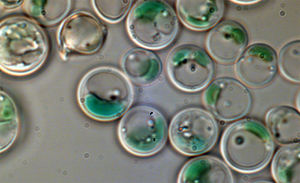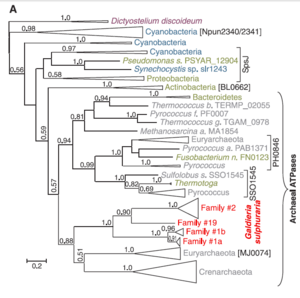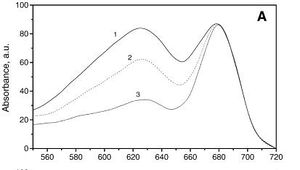Galdieria sulphuraria

Classification
Domain: Eukaryota; Class: Rhodophyta; Family: Cyanidiaceae; Genus: Galdieria
Species
Species: Galdiera sulphuraria
Description and Significance
Galdieria sulphuraria is a eukaryotic, spore-forming, coccus. G. sulphuraria appears yellow-green to dark blue-green grown heterotrophically in liquid culture, and often yellow or green in its natural environment[1]. It is an acidophile, as well a thermophile, and inhabits highly acidic springs at high temperatures[4].
G. sulphuraria is a mixotrophic organism capable of both photosynthesis and the catabolism of a wide variety of metabolites[3]. Its ability to survive in extreme environment as well as its production of phycocyanin (PC) have made G. sulphuraria a candidate for biotechnology applications in both bioremediation and PC production [5,9].
Genome Structure
G. sulphuraria has a 13.7 Mbp genome [6], with a G+C concentration of 37% [7]. Phylogenetic and genomic analyses supplied by, Gerald Schönknecht et al. revealed 75 indications of horizontal gene transfer from archaea and bacteria along with highly condensed protein coding regions within the G. sulphuraria genome [6]. It is speculated that minimally 5% of the functional genes were acquired in this way [1].
Success of G. sulphuraria in a diverse array of extreme habitats appears to be facilitated by the acquisition and subsequent duplication of variety of genes not limited to heat tolerant archael ATPases, bacterial halophilic sodium-proton antiporters and thermoacidophilic arsenical membrane protein pumps along with the metal reducing mercuric reductase native to proteobacteria [6].
In addition to extremophilic adaptations, fungal metabolite transporters contribute to G. sulphuria's ability to utilize a medley of unusual carbon sources and distinguish it genetically even from "closely" related species [6].
Cell Structure, Metabolism and Life Cycle
G. sulphuraria is a mixotrophic eukaryote presenting a multilobed chloroplast and net-like mitochondrion, is roughly round in shape, and reproduces via the formation of 4-32 spores[2]. More details about structure/reproduction?
G. sulphuraria is capable of metabolic flexability, with the ability to grow photoautotrophically, photoheterotrophically, or chemoheterotrophically on greater than 50 carbon sources [3]. Experiments in growing G. sulphuraria in laboratory conditions conditions determined that G. sulphuraria growth is optimal at about 150 g/liter of glucose or fructose, growth is inhibited above 200 g/liter, and does not occur above 400 g/liter [1]. Grown autotrophically, the photosystems of G. sulphuraria have the absorption spectra on the left, with peaks at the ~620 and ~680nm wavelengths[9].
"G. sulphuraria copes with toxic metals typically found in volcanic areas and acid mine drainage by a variety of metal transporters (table S3). Different plasma membrane uptake systems for divalent metal cations permit the selective uptake of essential metals (such as iron or copper) at high concentrations of toxic metals (such as aluminum or cadmium). G. sulphuraria can also neutralize biohazardous metals, making it potentially useful in biotechnological applications."[6]
"How does G. sulphuraria maintain near-neutral cytosolic pH against a 106-fold H+ gradient across its plasma membrane (15, 16)? There is no evidence for an enhanced capacity to pump H+ out of the cytosol (which would be an energetically intense strategy). Yet, there are indications of a reduced H+ permeability of the plasma membrane. For G. sulphuraria, one voltage-gated ion channel gene was identified in the genome, compared to three in C. merolae (table S3) and 16 or more in other unicellular algae. Voltage-gated ion channels allow single-file diffusion of water, and therefore have a very high conductance for protons. A plasma membrane devoid of protonconducting voltage-gated ion channels probably has a low H+ permeability, preventing the acidification of the cell interior even at very high external H+ concentrations. G. sulphuraria shows an expansion of both, the intracellular chloride channel (CLIC) family and the chloride carrier/ channel (ClC) family (table S3), which do not conduct protons."[6]
Ecology

G. sulphuraria is found in extreme habitats such as the hot sulfur springs of Italy, Russia, Yellowstone park, and Iceland in pH values between 0 and 4 and in temperatures up to 56 degrees Celsius [4]. The high heavy metal concentrations found in many of these environments have also necessitated the evolution of adaptations to tolerate these conditions[3].
G. sulphuraria can make up up to 90% of the total microbial mass in some environments [1], however it often exists alongside Cyanidioschyzon merolae and Cyanidium caldarium [7].
Applications to Biotechnology
As mentioned in the Description and Significance section, G. sulphuraria has possible uses in both bioremediation and production of phycocyanin (PC) [5,8]. In the case of PC, G. sulphuraria strain 074G grown on glucose produces 20-287 times the amount of PC produced by Spirulina platensis, currently used in commercial PC production. Another advantage of G. sulphuraria is that it produces PC aphotically whereas S. platensis requires light for PC production, making potential commercial production easier [5]. G. sulphuraria is also a potential candidate for future applications in bioremediation due to its ability ability to neutralize some biohazardous metals [6].
References
[1] http://link.springer.com/content/pdf/10.1007%2Fs00253-007-1150-2.pdf
[2] http://link.springer.com/content/pdf/10.1023%2FA%3A1004035224715.pdf#page-1
[3] http://www.ncbi.nlm.nih.gov/pubmed/23471408
[4] http://genomics.msu.edu/galdieria/about.html
[5] http://onlinelibrary.wiley.com.proxy1.cl.msu.edu/doi/10.1002/bit.20417/pdf
[8] http://www.ncbi.nlm.nih.gov/pubmed/15604662


